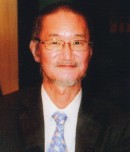

Plenary Lecture
Relationships Among the Hippocampus, Dentate Gyrus, Mammillary Body, Fornix, and Anterior Commissure from a Viewpoint of Elements

Professor Yoshiyuki Tohno
Department of Anatomy
Faculty of Medicine
Chiang Mai University, THAILAND
E-mail: ytohno@med.cmu.ac.th
Abstract: To elucidate compositional changes of the brain with aging, the author previously investigated age-related changes of elements in the corpus callosum, anterior commissure, and fornix of the white matter and the pineal body, olfactory bulb and tract, mammillary body, hippocampus, dentate gyrus, basal ganglia, superior colliculus, and lateral geniculate body of the gray matter and found that the Ca content increased significantly in the mammillary body, hippocampus, and putamen with aging, and the Mg content increased significantly in the hippocampus, fornix, putamen, and globus pallidus. The elements changing significantly with aging were different among the various brain regions.
To elucidate the relationships among the brain regions belonging to the limbic system, the author investigated the relationships among the hippocampus, dentate gyrus, mammillary body, and fornix, using the anterior commissure as a control, from a viewpoint of elements. After ordinary dissections at Nara Medical University were finished, the hippocampi, dentate gyri, mammillary bodies, fornices, and anterior commissures were removed from identical cerebra of Japanese subjects. The subjects consisted of 23 men and 23 women, ranging in age from 70 to 101 years (average age=83.5±7.5 years). After incinerating with nitric acid and perchloric acid, element contents were determined by inductively coupled plasma-atomic emission spectrometry. With regard to seven elements of Ca, P, S, Mg, Zn, Fe, and Na, it was examined whether there were significant correlations among the hippocampus, dentate gyrus, mammillary body, fornix, and anterior commissure. It was found that there were extremely or very significant direct correlations among all of the five brain regions of the hippocampus, dentate gyrus, mammillary body, fornix, and anterior commissure in the P content. Likewise, with regard to the Fe content, there were significant direct correlations among the four brain regions belonging to the limbic system, except for the anterior commissure. In both the Ca and Zn contents, there were extremely or very significant direct correlations among the hippocampus, dentate gyrus, and mammillary body of the gray matter. Assuming that the P content indicates metabolically active cell density, namely, the number of active cells per volume, there may be significant direct correlations among active cell densities of the hippocampus, dentate gyrus, fornix, mammillary body, and anterior commissure. In other words, the cerebrum with a high active cell density in one brain region also has high active cell densities in the other brain regions.
Brief Biography of the Speaker: Yoshiyuki Tohno was born in Osaka, Japan, in 1944. He graduated from Nara Medical University, Japan, in 1969. He received Medical Doctor Degree from Nara Medical University, Japan, in 1984. From 1984 to 1996, he was an Associate Professor at the Department of Anatomy, Nara Medical University, Japan. From 1996 to 2009, he was a Professor at the Department of Anatomy, Nara Medical University, Japan. In 2009, the title of Professor emeritus was bestowed upon him from Nara Medical University. Since 2004, he has been a Visiting Professor of Fujian Medical University, P. R. China. From 2009 to the present, he has been a Visiting Professor at the Department of Anatomy, Faculty of Medicine, Chiang Mai University, Thailand. He is mainly interested in compositional changes of human tissues, such as the arteries, cardiac valves, sino-atrial node, myocardium, brain, cartilages, bones, ligaments, and tendons with development and aging. He is an active member of New York Academy of Sciences, a member of International Association of Bioinorganic Scientists, a member of Fuzhou Giant Panda Research Center, P. R. China, a member of Primate Research Institute of Kyoto University, and on the Editorial Boards of Nephrology: Advances and Applications and ISRN Vascular Medicine.